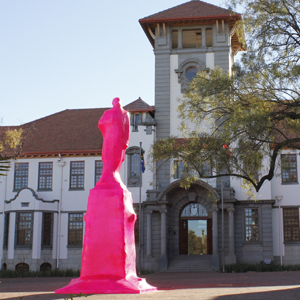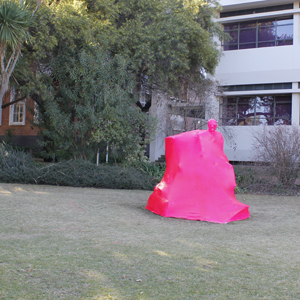Latest News Archive
Please select Category, Year, and then Month to display items
10 March 2022
|
Story Anthony Mthembu
|
Photo Unsplash
 The No Student Hungry team gearing up to start distributing food parcels to the selected students.
The No Student Hungry team gearing up to start distributing food parcels to the selected students.
The UFS is one of the many institutions of higher learning where food insecurity is an active issue. However, the
No Student Hungry Programme is one of the initiatives launched at the university to assist in fighting food insecurity at the institution.
The purpose of the programme
Since its inception in 2011, the initiative has assisted many students in acquiring a healthy meal. Additionally, the Food Environment Office also hands out food packages, so that students can continue to achieve academically. “We are trying to develop a healthy environment for students and make it easier for them to have a nice and healthy meal,” stated Annelize Visagie, who heads the Food Environment Office at the UFS. The Food Environment programme is spread out on all three campuses, each with its own facilitators. Furthermore, the programme mainly caters for students who are not funded by the National Student Financial Aid Scheme (NSFAS) but who are excelling academically. The abovementioned students apply for assistance online, and a list is then drawn up of students who receive assistance for the year.
Alternative solutions to keep the initiative running
On the Bloemfontein Campus, the No Student Hungry Programme will be catering for 200 students in the 2022 academic year, assisting them with a daily nutritious meal. Additional food parcels are also handed out to provide further assistance. “We give food parcels to the students on the list every Tuesday and Thursday at the Thakaneng Bridge,” Visagie highlighted. However, she argues that catering for the student population through this programme can be a challenge, as the demand for assistance is growing rapidly and the ability to assist is limited. The programme relies on partnerships and sponsors to assist the student body. In fact, the coordinators of the programme currently have a memorandum of understanding with Tiger Brands according to which they deliver around 100 food parcels for distribution.
In addition, the coordinators have put in place alternative measures to ensure that they can provide more food to students. “The
Kovsie Act Office, in partnership with the
Department of Sustainable Food Systems and Development, has started a food garden where healthy and nutritious produce are grown, in order to add value to the distribution,” she indicated. Although the programme can only assist to a point, students who are in desperate need of assistance are never turned away. In fact, the
Social Support Unit at Thakaneng Bridge usually assists students with food vouchers for a maximum of four days.
A commitment to teaching healthy eating habits
The programme is not only committed to curbing food insecurity, but also to ensuring that students have a healthy and balanced diet. As such, a booklet is being issued by the
Department of Nutrition and Dietetics in collaboration with the Department of Sustainable Food Systems and Development, which contains ways in which students can make a healthy meal using some of the ingredients offered in the food parcels.
“We want to teach students how to eat healthy in the cheapest way, because they don’t have a lot of money to buy expensive food products,” Visagie argued.
Pres Steyn turns pink in anticipation of Vryfees
2014-06-06
Video clipLive streaming  |
Australian artist Cigdem Aydemir vacuum packed the Pres Steyn monument on the Bloemfontein Campus’s Red Plain – in pink. Aydemir’s project, ‘Plastic Histories’, forms part of a public art project that encourages us to evaluate public monuments in their historical context.
By vacuum packing monuments, Aydemir alludes to their significance and preservation. At the same time, though, it reveals the nature of their contentious and gendered historical function. This is because most monuments in post-colonial countries typically celebrate men’s achievements in serving their nations.
In response, this project acknowledges the contribution of women from all races, communities and sexual orientations to the grand narrative of a post-apartheid South Africa.
Aydemir is also developing an app in collaboration with Australian artist Warren Armstrong. This will be used for augmented reality viewing of three city monuments – those of President Brand, General De Wet and General Hertzog. This means that visitors will be able to hold a smart phone or iPad in front of the monuments and view the monuments as if vacuum packed in pink plastic.
In conjunction with the public art project there will be an exhibition of digitally manipulated photographs of nineteen-century and contemporary male monuments in Bloemfontein. These photos will be exhibited at the Johannes Stegmann Gallery at the UFS Sasol Library from 15 July – 1 August 2014.
Public tours on the Bloemfontein Campus and into the city will take place on:
• Tuesday 15 July at 11:00,
• Wednesday 16 July at 14:00, and
• Saturday 19 July at 11:00.
 |
Aydemir’s ‘Plastic Histories’ public art project is part of the UFS Programme for Innovation in Artform Development (PIAD) and the Vryfees arts festival’s partnership with the Australian-based SituateArt in Festivals initiative. This partnership is managed by the Salamanca Arts Centre in Tasmania.
Read more articles about this project:
POZIBLE launch (pdf document)
Media release: 17 June 2014: Art Stars Revealed (pdf document)
PIAD/PIKO - http://bit.ly/1gazQTV
OPENLab - http://bit.ly/1hzguUG
CAD Forum - http://bit.ly/1sNvtRB